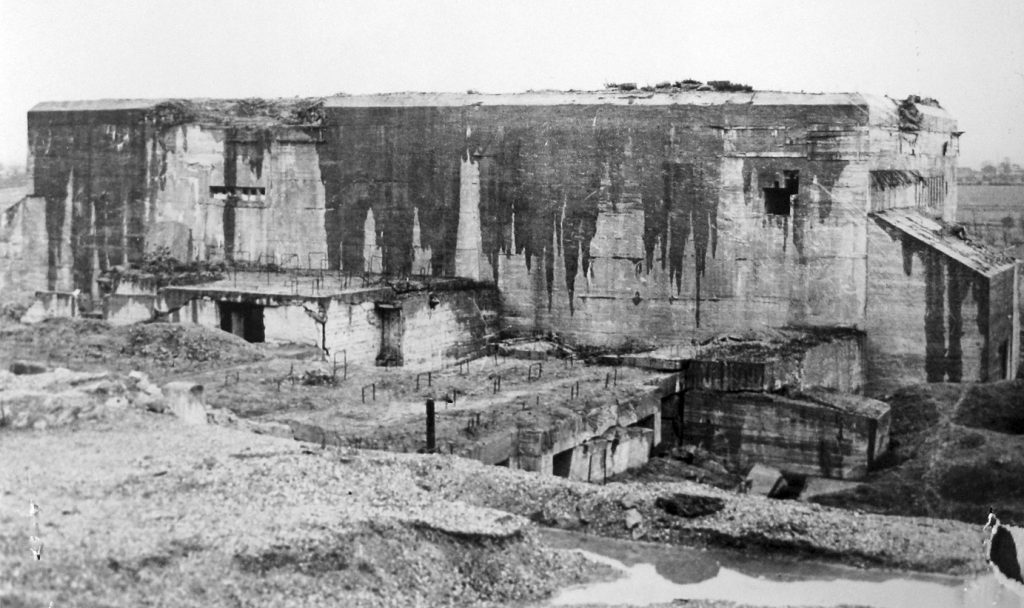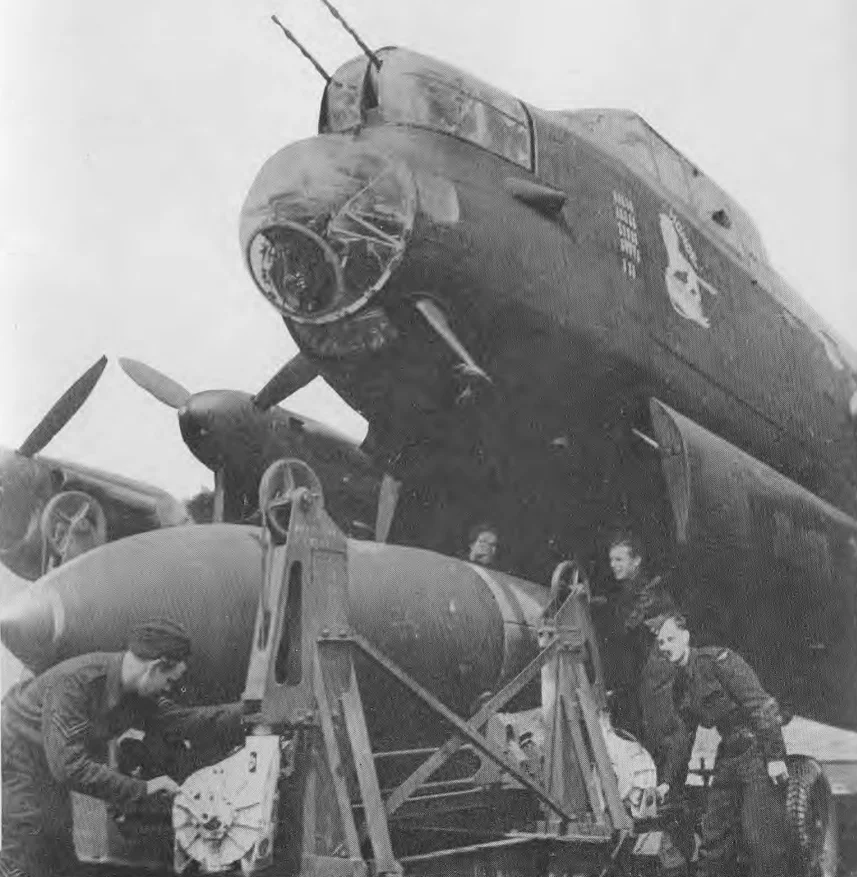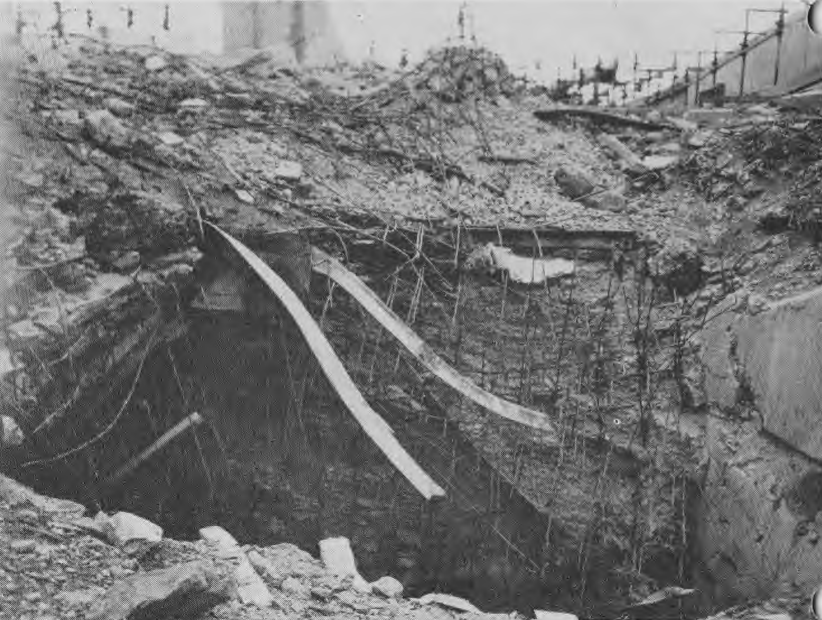
Tallboy: the 12,000 lb Earthquake Bomb
The Tallboy bomb, developed during World War II by British engineer Sir Barnes Wallis, was an aerial bomb designed for deep penetration, allowing it to target heavily fortified structures and underground facilities.
Weighing approximately 12,000 pounds and filled with the potent explosive Torpex, it was dropped from high altitudes, achieving near-supersonic speeds to maximize its penetrative capability.
Its most notable achievement was the sinking of the German battleship Tirpitz, demonstrating the Tallboy’s strategic impact on the war.
Background
The urgent imperatives of wartime often necessitate groundbreaking innovation. Such was the case during World War II when the Allies, facing seemingly impervious German defenses, were compelled to think beyond traditional warfare methodologies.
Central to this evolution in thinking was Sir Barnes Wallis, already renowned for his creation of the “bouncing bomb” utilized in the audacious Dambusters raid.
However, as the war progressed, Wallis turned his attention to a new challenge: how to target and eliminate the German infrastructure that remained protected beneath layers of earth or reinforced concrete.
 A bouncing bomb being dropped by a Lancaster.
A bouncing bomb being dropped by a Lancaster.
After occupying much of Europe, Germany began building extensive fortifications, both as defensive lines and to protect military installations and factories. These structures were extremely well-protected, with some measuring up to 8 meters thick, comprised of multiple layers of concrete, granite, steel and other materials.
They were virtually immune to conventional bombs, so a different approach was needed to tackle them.
Drawing from his background that bridged both engineering and geology, Wallis postulated a groundbreaking concept. Instead of targeting the surface of these fortified structures, what if a weapon could be designed to plunge deep into the ground, unleashing its explosive force from below?
 Blockhaus d’Éperlecques, also known as the Watten bunker. Parts of this bunker were up to 7 meters thick.
Blockhaus d’Éperlecques, also known as the Watten bunker. Parts of this bunker were up to 7 meters thick.
Such a detonation would use the principle that energy travels through a solid much more efficiently than it does through air.
This subterranean explosion would “shove” the structure, sending shockwaves directly into its foundations. Such an event could cause the bunker to collapse, but even merely cracking it could misalign it and prevent further use.
Wallis envisioned a bomb dropped from the sky that, upon impact, would penetrate deep underground before detonating.
However, the actualization of this vision posed considerable challenges. The chief of which was: how do you get a large quantity of explosives underground? Such a weapon would need to possess an extremely tough exterior to withstand the impact with the ground, all while ensuring that the internal explosives did not prematurely detonate.
 The Tallboy bomb. Image by RF CC BY-SA 3.0.
The Tallboy bomb. Image by RF CC BY-SA 3.0.
Furthermore, this bomb would need to be aerodynamically designed to achieve a high terminal velocity, ensuring deep penetration before explosion.
Wallis’s relentless experimentation and commitment to this vision eventually culminated in the creation of the Tallboy bomb.
As the weapon moved from the drawing board to the battlefield, it became apparent that Wallis’s innovative approach had given the Allies a potent new tool in their arsenal, capable of taking on some of the most formidable German defenses.
Design Of The Tallboy
The entire design of the Tallboy was to maximize speed and penetration.
One of the primary considerations when designing the Tallboy was the choice of material. The casing, constructed from single casting of high-tensile steel, boasted a thickness of up to 3.5 inches.
This significant thickness ensured that the bomb could endure the stress of impacting the ground at high speeds without disintegrating or detonating early. Moreover, it was this very rigidity that allowed the bomb to penetrate deep beneath the ground or even reinforced structures.
 A selection of bombs used by the Royal Air Force. The Tallboy is on the right.
A selection of bombs used by the Royal Air Force. The Tallboy is on the right.
Within this robust casing was the explosive content, which was as vital as the casing itself. The Tallboy was filled with Torpex, an explosive that was more powerful than standard TNT by approximately 50%.
Torpex’s increased power ensured that, once the bomb penetrated its target and detonated, the explosion would be of a magnitude enough to create the desired earthquake effect.
A bomb’s effectiveness isn’t determined by its explosive content alone. The ability of the bomb to reach its target with precision and at the desired speed is equally crucial.
Wallis and his team ensured that the Tallboy had a streamlined design, reducing drag and maximizing its descent speed when dropped from high altitudes. This aerodynamic efficiency allowed the Tallboy to reach speeds up to 750 mph, guaranteeing deep penetration upon impact.
Slightly angled fins at the rear of the bomb caused it to spin, increasing its accuracy.
Its design also meant that, should the bomb score a direct hit, it could actually punch straight through the concrete roof and detonate inside the bunker.
A cutaway of the Tallboy, showing its general construction.
The sheer size and weight of the Tallboy were instrumental in its operational efficiency. Weighing 12,000 pounds, or around 5.4 tons, it was one of the heaviest bombs used during World War II, even outweighing the atomic bombs dropped on Japan.
This weight was both a challenge and an asset.
While it required specially modified aircraft to carry and deploy, the weight also played a critical role in achieving the desired penetration depth before detonation.
The Tallboy In Action
The Tallboy bomb, while impressive on paper, was quite a handful in real life. It was so large that only the British Avro Lancaster bomber could carry it, and only after modifications.
As the bomb needed to descend as fast as possible for maximum effect, it had to be released at an optimum altitude of around 18,000 ft. The subsequent detonation would create a crater 100 ft (30 meters) wide and 80 ft (24 meters) deep.
Entering service in 1944, the Tallboy was used against a wide variety of targets, including the German battleship Tirpitz.
 A Tallboy being loaded into a Lancaster. Lancasters were capable of carrying them, but their bomb-bays had to be modified for them to fit.
A Tallboy being loaded into a Lancaster. Lancasters were capable of carrying them, but their bomb-bays had to be modified for them to fit.
The German battleship Tirpitz, a sister ship of the Bismarck, was a major concern for the Allies. Anchored in the sheltered Norwegian fjords, the Tirpitz was a looming threat, capable of disrupting the Allied naval supply routes.
And, as sister ship to the Bismarck, it was a significant political target.
Despite its anchored state, its mere presence tied down significant Royal Navy assets to counter potential moves. Prior attempts, using conventional means, to destroy the Tirpitz had been largely unsuccessful due to its formidable defenses and strategic positioning.
 A Tallboy dropped over the Blockhaus d’Eperlecques in France.
A Tallboy dropped over the Blockhaus d’Eperlecques in France.
On November 12, 1944, Royal Air Force Lancaster bombers, armed with Tallboy bombs, initiated a daring raid against this seemingly invulnerable naval behemoth. While only two of the Tallboys scored direct hits, the potency of the bombs was evident.
The cumulative effect of the bombs, both direct and near misses, inflicted fatal damage. The concussive shockwaves from the Tallboy detonations breached the Tirpitz’s armor, causing the mighty battleship to capsize.
Beyond the Tirpitz, the Tallboy saw action against various strategic German installations. One notable target was a V-2 rocket production facility in France, known as La Coupole. This factory could assemble and launch V-2s, and was protected by a 55,000-ton concrete dome 5 meters thick.
 The dome above the La Coupole V-2 production site. The entire site was put of out action by Tallboys.
The dome above the La Coupole V-2 production site. The entire site was put of out action by Tallboys.
4,300 tons of conventional bombs had been dropped on the site with little effect, but a single Tallboy that landed nearby worked as intended and shattered the foundations of the bunker, putting it permanently out of action.
Additionally, the Tallboy was deployed against heavily fortified U-boat pens, which had roofs made of thick, reinforced concrete. These pens were virtually impervious to conventional bombings. The Tallboy, with its deep penetration capability, was one of the few weapons capable of breaching these defenses.
 Tallboy damage through the 6-meter thick roof of the Brest U-boat pengs.
Tallboy damage through the 6-meter thick roof of the Brest U-boat pengs.
Moreover, German transportation networks, especially vital railway viaducts, were targeted to disrupt troop and equipment movements. Destroying these viaducts crippled the enemy’s ability to transport reinforcements and essential supplies, further weakening the German war effort.
One such strike on a tunnel in Saumur, France, saw a Tallboy punch through 60 ft (18 meters) of earth and explode in a railway tunnel below.
Impact and Later Uses
The Tallboy stood as an exemplar of cutting-edge engineering. It combined aerodynamics, metallurgy, and explosives technology in a way that had not been seen before.
Its very design principles—deep penetration followed by underground detonation—paved the way for subsequent developments in ordinance design.
 A Tallboy is dropped from an American B-29.
A Tallboy is dropped from an American B-29.
The Tallboy’s successor lead to an even bigger version, the “Grand Slam”, which weighed 22,000 lbs (11 tons).
The operational success of the Tallboy forced a reconsideration of fortified defenses. Previously deemed impregnable structures, like the U-boat pens or reinforced bunkers, were now vulnerable.
The United States produced their own version of the Tallboy, which they designated T-10. The US intended to drop them from B-29s against Japanese targets in the Pacific.
These bombs were never used in anger during the war, and were placed into storage. Incredibly, during the 1960s the bombs were pulled out of storage for use in the Vietnam War.
 A BLU-82B “Daisy Cutter” bomb, as used in Vietnam. The probe at the front is a stand-off detonator that ensures the bomb detonates just above the ground. Image by Sixflashphoto CC BY-SA 4.0..
A BLU-82B “Daisy Cutter” bomb, as used in Vietnam. The probe at the front is a stand-off detonator that ensures the bomb detonates just above the ground. Image by Sixflashphoto CC BY-SA 4.0..
Their rear ends were removed, leaving just the warhead, which was airdropped from C-130s into the jungles of Vietnam. Descending under small parachutes, the bomb would detonate just above the ground and clear a large swath of jungle to allow for the insertion of special forces teams.
News
The Hanging Temple: China’s 1,500-Year-Old Cliffside Marvel of Faith and Engineering
The Hanging Temple: China’s 1,500-Year-Old Cliffside Marvel of Faith and Engineering Perched precariously on the cliffs of Mount Heng in Shanxi Province, China, the Hanging Temple, also known as Xuankong Temple, Hengshan Hanging Temple, or Hanging Monastery, is an architectural…
The Willendorf Venus: A 30,000-Year-Old Masterpiece Reveals Astonishing Secrets
The Willendorf Venus: A 30,000-Year-Old Masterpiece Reveals Astonishing Secrets The “Willendorf Venus” stands as one of the most revered archaeological treasures from the Upper Paleolithic era. Discovered in 1908 by scientist Johann Veran near Willendorf, Austria, this small yet profound…
Unveiling the Maya: Hallucinogens and Rituals Beneath the Yucatán Ball Courts
Unveiling the Maya: Hallucinogens and Rituals Beneath the Yucatán Ball Courts New archaeological research has uncovered intriguing insights into the ritual practices of the ancient Maya civilization. The focus of this study is a ceremonial offering found beneath the sediment…
Uncovering the Oldest Agricultural Machine: The Threshing Sledge’s Neolithic Origins
Uncovering the Oldest Agricultural Machine: The Threshing Sledge’s Neolithic Origins The history of agricultural innovation is a fascinating journey that spans thousands of years, and one of the earliest known agricultural machines is the threshing sledge. Recently, a groundbreaking study…
Nara’s Ancient Sword: A 1,600-Year-Old Protector Against Evil Spirits
Nara’s Ancient Sword: A 1,600-Year-Old Protector Against Evil Spirits In a remarkable discovery that has captured the attention of archaeologists and historians alike, a 7.5-foot-long iron sword was unearthed from a 1,600-year-old burial mound in Nara, Japan. This oversized weapon,…
The Inflatable Plane, Dropped Behind the Lines for Downed Pilots
Experimental The Inflatable Plane, Dropped Behind the Lines for Downed Pilots The Inflatoplane from Goodyear was an unconventional aircraft developed by the Goodyear Aircraft Company, a branch of the renowned Goodyear Tire and Rubber Company, also famed for the Goodyear…
End of content
No more pages to load











